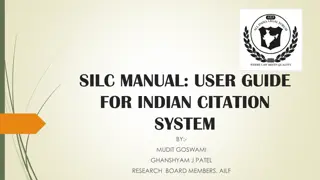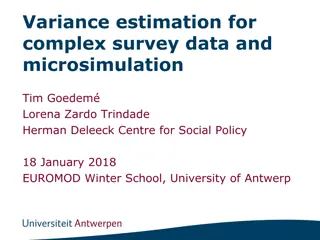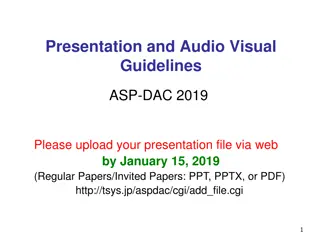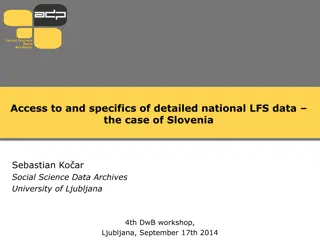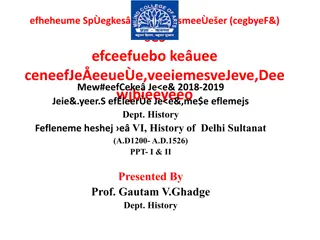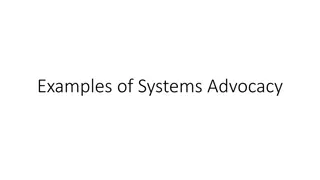
EU-SILC Longitudinal Training Courses Overview
Explore the comprehensive training courses on EU-SILC Longitudinal, covering scope, data organization, statistical concepts, and information sources. Learn about the SILC Instrument's content, participating countries, specific topics, and data organization methodologies as outlined by Eurostat.
Download Presentation

Please find below an Image/Link to download the presentation.
The content on the website is provided AS IS for your information and personal use only. It may not be sold, licensed, or shared on other websites without obtaining consent from the author. If you encounter any issues during the download, it is possible that the publisher has removed the file from their server.
You are allowed to download the files provided on this website for personal or commercial use, subject to the condition that they are used lawfully. All files are the property of their respective owners.
The content on the website is provided AS IS for your information and personal use only. It may not be sold, licensed, or shared on other websites without obtaining consent from the author.
E N D
Presentation Transcript
Introduction to EU-SILC DwB Training Courses on EU-SILC Longitudinal Paris, February 2014 Eurostat
AGENDA 1. Scope of the instrument 2. Organization of the data 3. Main statistical concepts 4. Information sources Eurostat
1. Scope of the SILC Instrument - OVERVIEW Annual data: cross-sectional and longitudinal (4-years-traces) Information on both households and individuals (micro level) Income and tax Material deprivation Housing conditions Employment, Childcare Health, Education Output harmonization Definition of target concepts/variables to be measured Standardized output (format and content) Common guidelines monitored by Eurostat Eurostat
1. Scope of the SILC Instrument - CONTENT Participating countries (by first year of implementation) 2003: BE, DK, EL, IE, LU, AT, NO 2004: EU-12 + IS, EE 2006: EU-25 + TR, BG 2007: EU-27 2010: HR Reference population: All private households and their current members Excluded: people in collective households and institutions Sample size Minimum precision criteria for key indicator, to produce results both at country and EU level (precision of at-risk-of-poverty rate of 1%) Eurostat
1. Scope of the SILC Instrument - SPECIFIC TOPICS Topics covered in the annual modules 2005: Intergenerational transmission of poverty; 2006: Social participation; 2007: Housing conditions; 2008: Over-indebtedness and financial exclusion; 2009: Material deprivation; 2010: Intra-household sharing of resources; 2011: Intergenerational transmission of disadvantages (~2005); 2012: Housing conditions (~2007); 2013: Well-being; 2014: Material Deprivation Variables included in the cross-sectional data / not in longitudinal EC-Regulation for each module Eurostat
2. Organization of the data BACKGROUND Regulations (European Law): Clear specifications of deliverables Obligation of Member States to deliver data Methodology to be followed " Guidelines Doc65_2011.pdf " Implementation: Surveys designed & carried out nationally Microdata validated first nationally then by Eurostat Indicators (aggregated data) computed and disseminated National and EU quality reports Eurostat
2. Organization of the data OVERVIEW National flexibility in the implementation: Source: survey and/or registers (DK, NL, SI, FI, SE, IS, NO) Fieldwork: one-shot ( length) or continuous survey Income reference period: fixed or moving 12-months Imputation method for income variables Survey design Logic of the data files: Linkable 4 files per country and year: D-file => Region, Deg_Urba, HH-weight, H-file => Income, Material Deprivation, R-file => Age, Gender, Personal weights, P-file => Health, Labour, Education, Longitudinal and cross-sectional files cannot be linked !!! Eurostat
2. Organization of the data PROCESSING Fieldwork in countries in year N Data transmission to Eurostat by November N + 1 Final checking (1-2 weeks) Upload of indicators (every mid-month) Compilation of explanations & quality reports Data release to researchers (UDB) in March N + 2 Including revisions from the previous operations Longitudinal files: same process, around 6 months later Eurostat
2. Organization of the data ANONYMISATION Some common rules for the UDB data: Region: changed from NUTS2 to NUTS1 Points of time: months recoded into quarter Number of rooms: top-coded to 6+ Age: top-coded to 80+ PSU: randomised Additional country-specific provisions Eurostat
3. Main statistical concepts BACKGROUND Typology of variables Discrete (nominal, ordinal, binary) & Continuous (i.e. income) Statistical units households with specific characteristics persons with specific characteristics persons living in households with specific characteristics Usage of weights for longitudinal analysis RB062 for transitions between year N-1 (2010) and year N (2011) RB063 for transitions within years N-2 and N RB064 for 4 years transitions Eurostat
3. Main statistical concepts INCOME DISTRIBUTION Background information: All Income data in the UDB is in Euro Exchange rates provided in the data, relevant PPS on CIRCABC Living standards affected by income, size and composition of the households Equivalisation of household income = HY020 Equivalisation scale a convention on needs Results in equivalised disposable income on personal level = HX090 All persons of a household 'receive' the same amount, don't sum it!!! Example: Share and cut-off points of percentiles Eurostat
3. Main statistical concepts LABOUR TRANSITIONS BasIs Employment status as the self-defined current economic status (variable PL031) Technics All persons aged between 16 and 64 years RB062 is used for weighting Interpretation Share of working-age persons who move between employment status (or retain the same status) between two consecutive years Eurostat
3. Main statistical concepts EMPLOYED PERSONS, 2010-2011 No change To unemployment To inactivity 100.0 90.0 80.0 70.0 60.0 50.0 40.0 30.0 20.0 10.0 0.0 Eurostat
3. Main statistical concepts UNEMPLOYED PERSONS, 10 - 11 No change To employed To inactivity 100.0 90.0 80.0 70.0 60.0 50.0 40.0 30.0 20.0 10.0 0.0 Eurostat
3. Main statistical concepts PERSISTENT POVERTY Basis monetary concept of relative poverty Equivalised disposable income (longitudinal) Threshold = 60% of the national median income (cross- sectional) Technics All persons being in the panel for 4 years RB064 is used for weighting Interpretation Share of people who were poor in the last year and at least 2 out of the preceding 3 years Eurostat
3. Main statistical concepts PERSISTENT POVERTY Persistent at-risk-of-poverty rate in 2011, in % of total population 18.0 16.0 14.0 12.0 10.0 8.0 6.0 4.0 2.0 0.0 Eurostat
4. Information Sources OVERVIEW Documentation on the CD-ROM SILC homepage Eurostat Data, Methodology, Legislation, Quality, Publications Statistics Income and Living Condition CIRCABC, EU-SILC user group, Library 4.1. User Database more information 3.2. Indicators all programs of Eurostat for indicators Eurostat
4. Information Sources SILC homepage Eurostat
Thank you for your attention Questions and comments Ideas for improvement Additional remarks in writing: Boyan.Genev@ec.europa.eu Eurostat





